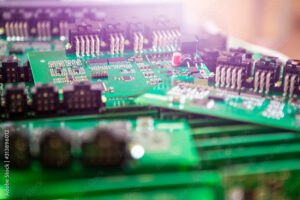
Metal-core printed circuit boards (MCPCBs) are becoming increasingly popular in automotive electronics due to their superior thermal performance and high reliability. We will explore the design and manufacturing considerations when using MCPCBs in automotive applications.
Design Considerations
When designing MCPCB for automotive electronics, there are several factors to consider:
- Thermal Management Automotive electronics generate a significant amount of heat, and effective thermal management is critical to ensure the long-term reliability of the system. MCPCBs offer superior thermal performance compared to traditional FR-4 PCBs, making them an ideal choice for high-temperature applications.
- Size and Shape Automotive electronics are often designed to fit within a specific space, and the size and shape of the MCPCB must be carefully considered to ensure that it fits within the system. MCPCBs offer greater design flexibility compared to traditional PCBs, making it easier to fit within tight spaces.
- Signal Integrity Automotive electronics rely on reliable signal transmission, and the design of the MCPCB must take into account the signal integrity requirements of the system. Proper trace routing and grounding techniques must be used to minimize signal loss and noise.
Manufacturing Considerations
When manufacturing MCPCBs for automotive electronics, there are several factors to consider:
- Material Selection The metal core of the MCPCB must be carefully selected based on the thermal and mechanical requirements of the application. Aluminum and copper are commonly used in automotive electronics due to their high thermal conductivity and mechanical strength.
- Manufacturing Tolerances Automotive electronics require high manufacturing tolerances to ensure that the system functions reliably over its lifetime. The manufacturing process for MCPCBs must be carefully controlled to ensure that the final product meets the
required tolerances. - Surface Treatment The surface treatment of the MCPCB is critical to ensure that the dielectric layer adheres properly to the metal core. Improper surface treatment can lead to delamination of the dielectric layer, resulting in system failure.
- Assembly Process The assembly process for MCPCBs must be carefully controlled to
ensure that the final product meets the required performance specifications. The components must be properly mounted on the MCPCB to ensure reliable electrical connections and proper thermal management.
Conclusion
In conclusion, MCPCBs offer several advantages in automotive electronics due to their superior thermal performance and high reliability. When designing and manufacturing MCPCBs for automotive applications, it's essential to consider factors such as thermal management, size and shape, and signal integrity.
The material selection, manufacturing tolerances, surface treatment, and assembly process must be carefully controlled to ensure that the final product meets the required performance specifications. MCPCBs are an ideal choice for high-temperature applications in automotive
electronics and can improve the reliability and performance of the system.